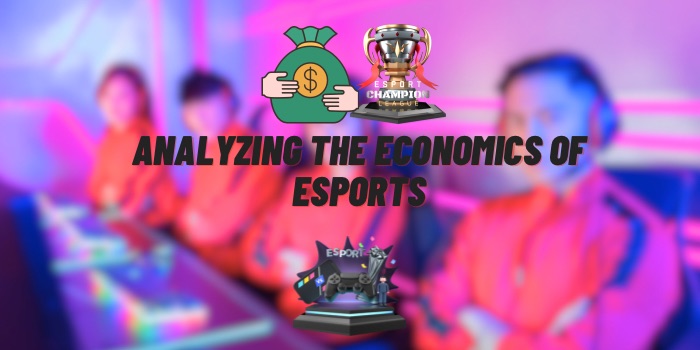Analyzing the Economics of Esports: Sponsorships, Prize Pools, and Revenue Streams
Esports, or competitive gaming, has rapidly evolved from niche competitions in arcades and small gatherings into a global phenomenon. In the late 1990s and early 2000s, early tournaments for games like StarCraft and Counter-Strike began to gain traction. However, it wasn’t until the late 2000s and 2010s that esports truly exploded in popularity, thanks to advancements in live streaming technology and the rise of platforms like Twitch. Today, esports commands millions of viewers worldwide, with major tournaments filling stadiums and drawing viewership numbers that rival traditional sports.
The financial growth of esports has been nothing short of remarkable. What was once considered a subculture has now become a multi-billion-dollar industry. Investment from major brands, media rights deals, and massive sponsorships have fueled this growth. According to market research, the global esports market was valued at over $1 billion in 2021 and continues to expand at an impressive rate. As esports gains mainstream recognition, its economic significance grows, attracting attention from a wide range of stakeholders, including investors, sponsors, and media companies.
This article aims to delve into the key financial components that drive the esports economy. We will explore the role of sponsorships, prize pools, and various revenue streams, providing a comprehensive analysis of how these elements contribute to the overall financial landscape of esports.
Sponsorships in Esports

Sponsorships have emerged as the lifeblood of the esports industry. For many esports organizations, sponsorship deals represent the largest portion of their revenue. Unlike traditional sports, where ticket sales and media rights might dominate, esports organizations rely heavily on partnerships with brands to sustain operations. This dependency has only increased as the industry grows, with sponsors seeking to capitalize on the highly engaged and youthful audience that esports attracts.
The Role of Big Brands and Non-Endemic Companies in Esports Sponsorships
Initially, esports sponsorships were dominated by endemic brands—companies directly related to gaming, such as hardware manufacturers and game developers. However, as the industry’s popularity surged, non-endemic brands began to recognize the potential of esports as a marketing platform. Today, major corporations across various sectors, including automotive, financial services, and even luxury goods, are investing in esports sponsorships. For instance, companies like Coca-Cola, Mercedes-Benz, and Nike have all entered the esports arena, showcasing the broad appeal and marketing power of competitive gaming.
Types of Sponsorship Deals
Sponsoring individual players and teams is one of the most common forms of sponsorship in esports. Brands like Red Bull and Nike have entered into lucrative deals with top esports athletes, similar to traditional sports sponsorships. Teams also secure sponsorships to cover operational costs, player salaries, and other expenses. For example, gg253 bet, a betting company, has become a prominent sponsor in the esports scene, particularly within the CS:GO community. They provide financial backing in exchange for branding rights on team jerseys, streaming overlays, and social media content, thereby increasing their visibility among a dedicated audience.
Event Sponsorships
Esports tournaments and leagues are also prime targets for sponsorships. Companies sponsor events in exchange for branding opportunities, including in-game ads, logos on the broadcast, and naming rights. High-profile tournaments like the League of Legends World Championship often attract multiple sponsors, creating a competitive environment where brands vie for visibility.
Streaming Partnerships
Platforms like Twitch, YouTube, and Facebook Gaming have become central to the esports ecosystem, providing the primary means for fans to watch live events. As a result, partnerships with these platforms are highly valuable. These deals can involve exclusive streaming rights, branded content, and integrated advertising. For example, Twitch has partnered with several major esports events, enhancing both its platform’s reach and the events’ viewership numbers.
Impact of Sponsorships on the Industry
Sponsorships significantly impact the financial health of esports teams. They allow teams to offer competitive salaries, invest in top-tier facilities, and expand their operations globally. Additionally, sponsorships enable teams to recruit and retain talent by offering more attractive financial packages. The influx of sponsorship money has also led to the professionalization of the industry, with teams adopting business practices similar to those of traditional sports franchises.
Case Studies of Significant Sponsorship Deals in Esports
One notable example is the partnership between Mercedes-Benz and ESL, one of the largest esports organizers in the world. This deal not only provided ESL with financial support but also elevated the brand image of esports by associating it with a luxury automotive brand. Another significant deal is Intel’s long-standing sponsorship of the Intel Extreme Masters (IEM), which has helped establish the IEM as one of the most prestigious tournaments in esports.
Prize Pools in Esports
Prize pools in esports have grown exponentially over the past decade. In the early days, winning a tournament might have earned a player or team a few thousand dollars. Today, top-tier tournaments boast prize pools that rival or even surpass those of some traditional sports events. This growth is largely attributed to the increasing popularity of esports and the financial backing from sponsors and game developers.
Comparison of Prize Pools Across Different Games and Tournaments
Different games and their respective communities have seen varying levels of prize pool growth. Dota 2, for instance, is known for its massive prize pools, with The International setting records each year, thanks in part to its crowdfunding model. League of Legends also offers significant prize money, though its structure tends to be more evenly distributed among participants. Fortnite, with its broad appeal and younger audience, has also made headlines with its enormous prize pools, particularly in its inaugural World Cup.
High-Profile Tournaments and Their Economic Impact
These flagship tournaments not only offer substantial prize money but also generate significant revenue through ticket sales, streaming rights, and merchandise. The International, for example, has consistently raised tens of millions of dollars for its prize pool, largely through community contributions via in-game purchases. Similarly, the League of Legends World Championship garners millions of viewers, with Riot Games investing heavily in its production value and marketing.
The Role of Crowdfunding and Community Involvement in Prize Pool Creation
Crowdfunding has become a popular method for boosting prize pools, particularly in Dota 2. The International’s prize pool is partly funded by the sale of in-game items, with a percentage of sales going directly to the pool. This model not only increases the prize money but also engages the community, giving fans a direct stake in the success of the tournament.
Distribution of Prize Money
Prize money distribution varies by tournament and game. In some cases, the majority of the prize money goes to the winning team, while smaller portions are allocated to runners-up. Teams often negotiate prize splits with players, with some opting for equal distribution and others favoring higher payouts for star players. Additionally, organizations may take a percentage of the winnings to cover operational costs.
The Impact of Prize Winnings on Player Earnings and Team Sustainability
Prize money can significantly boost a player’s income, particularly for those at the top of their game. However, reliance on prize winnings can be precarious, as success in tournaments is not guaranteed. For teams, consistent prize earnings can enhance financial stability, but they often seek to diversify income streams to reduce dependency on unpredictable tournament outcomes.
Revenue Streams in Esports

Merchandise has become an essential revenue stream for esports teams, with branded apparel, accessories, and in-game items generating significant income. Fans are eager to support their favorite teams and players, leading to strong sales of jerseys, hoodies, and other gear. In-game purchases, such as skins and cosmetics, also contribute to revenue, particularly when tied to esports events or teams.
In-game purchases linked to esports are a major revenue generator. Developers often release limited-edition skins or items during major tournaments, with a portion of the sales contributing to the event’s prize pool. These items are popular among fans, both as collectibles and as a way to support the esports scene.
Media Rights and Broadcasting
Media rights are another critical revenue source for the esports industry. Streaming platforms like Twitch, YouTube, and Facebook Gaming have entered into exclusive rights deals with esports leagues, paying significant sums to secure the rights to broadcast major events. These deals are often multi-year contracts and can include additional content like player interviews, behind-the-scenes footage, and more.
While esports media rights deals are not yet as lucrative as those in traditional sports, they are rapidly gaining value. Traditional sports networks like ESPN and Fox Sports have also started to dip their toes into esports, recognizing its growing popularity among younger audiences. The comparison highlights the potential for esports to become a major player in the global sports broadcasting market.
As esports viewership continues to grow, so too does the value of media rights deals. With millions of fans tuning in to watch their favorite teams and players, streaming platforms are willing to pay top dollar for the rights to broadcast these events. This trend is expected to continue, driving further investment into the industry.
Advertising and In-Game Sponsorship
In-game advertising and branded content are becoming increasingly prevalent in esports. Developers are finding creative ways to integrate ads into games without disrupting the player experience. This includes in-game billboards, branded items, and even sponsored game modes. These advertising opportunities provide a steady revenue stream for both developers and esports organizations.
One of the challenges with in-game advertising is ensuring that it does not detract from the player experience. Developers must strike a balance between monetization and maintaining the integrity of the game. Overly intrusive ads can lead to backlash from the community, while well-integrated branding can enhance the gaming experience and generate revenue.
Ticket Sales and Live Events
Live events are a significant part of the esports economy, with major tournaments attracting thousands of fans to arenas and stadiums. Ticket sales for these events provide a substantial revenue stream, particularly for top-tier competitions. Additionally, live events offer opportunities for merchandise sales, fan meet-and-greets, and other revenue-generating activities.
The COVID-19 pandemic had a profound impact on live esports events, leading to the cancellation or postponement of many tournaments. However, the industry quickly adapted by shifting to online competitions, which, while lacking ticket sales, continued to generate revenue through streaming and sponsorships. As the world recovers, live events are expected to return, but the experience of the pandemic has shown that esports can thrive in both physical and digital environments.
Challenges and Opportunities in Esports Economics
As esports continues to grow, so does the competition among teams, leagues, and sponsors. New teams and organizations are constantly entering the market, making it increasingly difficult for any single entity to dominate. This competition can lead to market saturation, where too many players and teams are vying for a limited number of sponsorships and viewership.
Certain game titles may face the risk of market saturation, where too many teams are competing in a single game, leading to diminished returns for everyone involved. Additionally, as new games enter the esports scene, they can fragment the audience, making it harder for established titles to maintain their player base and viewership.
Sustainability of Revenue Streams
While sponsorships and prize pools are currently the primary revenue streams for esports, there are concerns about the sustainability of this model. Sponsorship deals can be volatile, and prize pools are often dependent on a few major tournaments. To ensure long-term sustainability, esports organizations must diversify their revenue streams, exploring new opportunities such as media rights, merchandise, and in-game purchases.
The future of esports economics will likely involve a more diversified approach to revenue generation. This could include greater investment in media rights, expansion into new markets, and the development of proprietary content and platforms. By reducing reliance on any single revenue source, esports organizations can better withstand market fluctuations and ensure their long-term success.
Future Trends and Predictions
The integration of blockchain technology and non-fungible tokens (NFTs) into esports presents new opportunities for revenue generation. NFTs can offer fans unique digital collectibles, while blockchain can provide transparent and secure ways to handle transactions, prize distributions, and even governance within esports organizations. These technologies could revolutionize the way revenue is generated and distributed in esports.
As esports continues to expand globally, new markets are emerging as key drivers of growth. Regions like Southeast Asia, Latin America, and Africa are seeing rapid increases in esports participation and viewership. Tapping into these markets will be crucial for the continued growth of the industry, as they offer fresh audiences and new opportunities for revenue generation.
Conclusion
Esports has transformed from a niche hobby into a global industry driven by significant financial investments. Sponsorships, prize pools, and diverse revenue streams form the backbone of this industry, each playing a crucial role in sustaining its growth. The increasing involvement of major brands, the evolution of prize pools, and the expansion of revenue streams highlight the dynamic and rapidly changing nature of esports economics.
Looking ahead, the future of esports economics appears bright but will require careful navigation of challenges such as market saturation and the reliance on volatile revenue streams. By embracing new technologies like blockchain and expanding into emerging markets, the industry can continue its upward trajectory, securing its place as a major player in the global entertainment landscape.
As the esports industry continues to grow, now is the time for stakeholders to invest in its future. Whether through sponsorships, media rights, or new revenue models, there are ample opportunities to contribute to and benefit from the rise of esports. For fans, players, and investors alike, the world of competitive gaming offers a vibrant and exciting ecosystem ripe for exploration and growth.






